We are excited to announce our 2024 webinar list has been finalized.
To see the list of webinars click here.
We are excited to announce our 2024 webinar list has been finalized.
To see the list of webinars click here.
Farzaneh Ahmadi, a Ph.D. student in the Electrical and Computer Engineering (ECpE) department, is the recipient of the Research Excellence Award presented by ISU’s Graduate College. This award is in recognition of her outstanding research accomplishments in a graduate program. Her research focus involves developing In-line nondestructive evaluation methods for polymer- and metal-based additive manufacturing (AM) processes under the direction of Dr. Reza Zoughi through the Center for Nondestructive Evaluation (CNDE).
The intent of this program is to recognize “the best of the best” graduating students. This award aims to recognize graduate students for outstanding research accomplishments as documented in their theses and dissertations. Students are expected to be academically superior and able to not only do the research but also to develop a well-written product.
Featured Researcher
Name: Stephen Holland
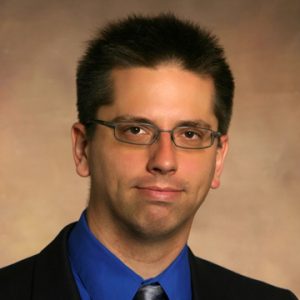
How long have you been at CNDE? Since 2002
Area(s) of expertise: Thermography, ultrasound, NDE data integration and digital twin
Who or what inspired you to pursue your career in NDE? I stumbled across laser ultrasonics as a student intern at Sandia Labs because it was a more interesting topic than boring virtual reality computer work. Back at university, I was inspired to continue after starting undergraduate research in Wolfgang Sachse’s lab. Five years later, I had my PhD and started at Iowa State.
Briefly describe one of your technical contributions to the NDE field. Discovery and explanation of the significance of a zero-group-velocity plate wave resonance that dominates air-coupled ultrasonic transmission, is fundamental to impact echo testing of civil structures, and also important in laser ultrasound.
What advice would you give a researcher just starting out in the NDE field? To study as much math and engineering physics as you can.
Name: Henry Moldenhauer
Research areas of interest: Thermography, solid mechanics modeling for NDE, resonant testing for materials characterization.
Anticipated graduation date: December 2024
Who or what inspired you to pursue your studies in NDE? During my final year as a civil engineering student, I looked into graduate programs in engineering mechanics. I g ot in contact with Dr. Stephen Holland at the Center for Nondestructive Evaluation (CNDE) and became one of his students. Before this, I had little knowledge of NDE, but I grew to appreciate the wide variety of topics within the field. The types of problems and projects that I have had the opportunity to work on with Dr. Holland and others at CNDE have really cemented my interest in the field.
ot in contact with Dr. Stephen Holland at the Center for Nondestructive Evaluation (CNDE) and became one of his students. Before this, I had little knowledge of NDE, but I grew to appreciate the wide variety of topics within the field. The types of problems and projects that I have had the opportunity to work on with Dr. Holland and others at CNDE have really cemented my interest in the field.
Briefly describe something you have learned or discovered during your time at CNDE that surprised you. I was most surprised by how interdisciplinary the field of NDE is. I’ve found it to be more of an intersection of many interesting fields. On a single project, you may have researchers with experience in different NDE modalities (e.g. electromagnetic methods, ultrasound, thermography, etc.) as well as researchers specializing in other topics like statistics or computational methods. This interdisciplinary approach has not only allowed me to build a much broader background of information, but it has also allowed me to contribute to a much wider variety of projects than I might have in other fields.
What are your future career plans? I am actively exploring opportunities within the field of NDE. My main goal is to continue to be able to work on solutions to a variety of interesting problems. If possible, I want to find ways to share what I have learned with others interested in NDE.
Henry is the recipient of the O.D. & O.U. Trapp Graduate Fellowship through CNDE.
Name: Mingyang Lu
How long have you been at CNDE? I began at CNDE in April 2023.
Area(s) of expertise: Electromagnetic eddy current experiments and computational modeling.
Who or what inspired you to pursue your career in NDE? I had an interest in electromagnetics as an undergraduate (before 2014) electrical and electronic major at the University of Manchester (#27 in QS World University Rankings) in the UK. During the last semester of my undergraduate, I joined a project from the Sensing Imaging and Signal Processing Group for the sensing-based dynamic control of robot carts. I heard one day that the Electromagnetic Sensing Group has actively engaged with industries, sustainably raised substantial funding from the British government, and in partnership with the internationally leading Research Centre for Nondestructive Evaluation (RCNDE) and industries. I came to join the Electromagnetic Sensing group in 2014 and completed my PhD in 2018.
In 2018, I worked as a postdoctoral researcher with the Electromagnetic Sensing Group, collaborating on projects with industry leaders like Frenk Van Den Berg from Tata Steel and Axel Rimnac from Primetals Technologies. Our work aims to address industrial challenges, such as electromagnetic eddy current inspection in Additive Manufacturing (AM): Electromagnetic non-destructive testing for inspecting the microstructure of high-performance ferritic steels and Advanced electromagnetic Sensors for Assessing Property scatter in high-value steels.
Before joining the CNDE, I authored around 60 publications in electromagnetic eddy current sensing and presented at prestigious conferences such as those organized by the British Institute of Non-Destructive Testing (BINDT), the European Federation for Non-Destructive Testing (ECNDT), and IEEE. Now, I feel very honored to be one of the CNDE researchers, and I believe CNDE is one of the best in the world.
Briefly describe one of your technical contributions to the NDE field. One of the technical highlights that comes to my mind is my recent work in the CNDE, under the IAB-funded project targeting a building of high-precision eddy current inspection system. This work pioneered an automatic inspection design, in which a fast and precious dynamic control of sensor scanning coordinates is assured by leveraging the robot arm or linear steppers with instrumentations. This development facilitates the eddy current NDE inspection with an enhanced signal-to-noise ratio and versatile capabilities, especially for the imaging of small defects (less than 20 microns) or detection of subsurface defects underneath coatings.
What advice would you give a researcher just starting out in the NDE field? Focus on deeply understanding core concepts, avoiding rushing into superficial approaches. Allocate ample time for thorough analysis, drawing insights from first principles. Seek supportive work environments like CNDE, fostering collaboration and innovation. Stay updated on the latest advancements through literature, conferences, and networking. Embrace continuous learning for long-term success and impactful contributions to the field.
CNDE hosted its Spring 2024 Industrial Advisory Board (IAB) Meeting on April 15-17.
CNDE researchers presented updates on five research projects that started in August 2023. Board members reviewed the project presentations and gave feedback on each project.
Also presented were nine proposals from CNDE researchers on various topics selected by our members for potential funding.
J.T. (Toby) Case for The Aerospace Corporation presented the post-IAB seminar on “Portable Open-Configuration Computed Tomography.”
IAB members from ASNT, ATI, Boeing, Cummins, GE Aerospace, General Motors, Honeywell Aerospace, IHI Corporation, John Deere, NASA Langley, Naval Nuclear Laboratory (NNL), Northrop Grumman, Pratt & Whitney, Rolls-Royce, and the US Air Force were in attendance, as were five invited guests from other industries.
The careers of five CNDE scientists and staff members were celebrated during the IAB Meeting on April 15.

From left: Dave Utrata – 30 years, Ron Roberts – 35 years, Cheryl Sansgaard – 45 years, Scott Wendt – 30 years, and Dan Barnard – 28 years.
Graduate students and faculty members from ECpE, IMSE, and ME showcased their research projects on April 15.









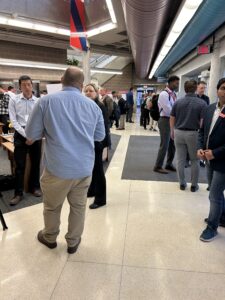


On April 16, students were able to connect with our members and guests during the Pizza with Students event at the Student Innovation Center.
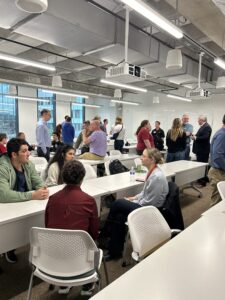




Thank you to all who were able to attend!


CNDE Director Dr. Reza Zoughi is the subject of SCOPE AT WORK profile in the April 2024 ASNT Materials Evaluation edition. Click here to read more.
CNDE participated in this year’s 2024 State Science & Technology Fair of Iowa on April 4 and 5. This two-day fair, organized by Iowa State University Extension and Outreach, was for students in grades 6 – 12 and provided a space to showcase their research projects. Students also got the chance to meet with professionals in all areas of science and technology.
CNDE welcomed 16 students to visit our labs and meet with our researchers. The tour topics included Terahertz, Ultrasonics, Microwave, Eddy Current, and X-ray Radiography. This was a great opportunity to introduce students to NDE at a young age.
CNDE also sponsored several cash prize awards for top NDE-related research projects. Two NDE Minor students graciously volunteered their time to judge these projects and accompany fair students on the CNDE tour.
Eddy Current Lab Tour



Microwave Lab Tour

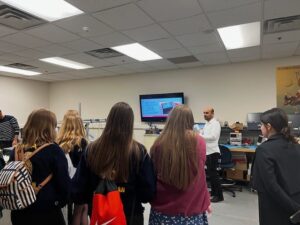

Terahertz Lab Tour


Ultrasound Lab Tour

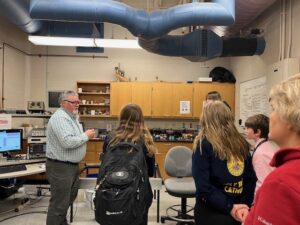

X-Ray Lab Tour



Group photo

The American Society of Nondestructive Testing (ASNT) Iowa section hosted a technical talk on Thursday, April 4th. Six members of the Ames Fire Department spoke about thermography applications in firefighting, including somewhat recent cases involving the detection of faulty wiring and the detection of corn syrup and propane leaks after a train derailment. Twenty students in attendance were able to use a FLIR camera with a refresh rate of 60 Hz, which one of the firefighters said was not fast enough to sweep through rooms quickly. Several students were awarded one-year ASNT student membership. As a thank you to the crew for their time, the ASNT officers awarded them a $100 pizza gift card.
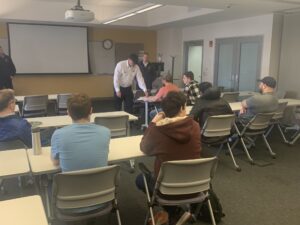
Name: Anna Case
Research areas of interest: Microwave and millimeter wave materials characterization

Who or what inspired you to pursue your studies in NDE? As a sophomore in electrical engineering, I was hired by Dr. Zoughi to work in the Applied Microwave Nondestructive Testing Lab. At the time, I was happy to have the opportunity but didn’t know if it would lead to a career. Several years later, I can say that everyone I work with, including my mentor, David Moore from Sandia National Labs, has continued to encourage me to stay in the field.
Briefly describe something you have learned or discovered during your time at CNDE that surprised you. What surprised me the most about coming to CNDE was the difference in work as an undergraduate and as a graduate research assistant. As an undergraduate student, you are given very specific tasks to accomplish, while as a graduate student, you have more open-ended questions to answer. It’s important to continue to state the tasks you perform so that you know what you have done – even if it doesn’t always answer the question at first.
What are your future career plans? I am joining the NDE team at Sandia National Labs in Albuquerque, NM. I hope to expand my NDE experience with CT, ET, and UT. I plan to stay involved with the American Society of Nondestructive Testing (ASNT) and the Institute of Electrical and Electronics Engineers (IEEE).
Anna is the recipient of the O.D. & O.U. Trapp Graduate Fellowship through CNDE.
 The February issue of Materials Evaluation (ME) just published an article announcing the strategic partnership between ASNT and CNDE. We are happy to announce that Neal Couture, the Chief Executive Officer of ASNT, will attend the Spring IAB meeting and outline future courses of action/plans intended to enhance this strategic partnership.
The February issue of Materials Evaluation (ME) just published an article announcing the strategic partnership between ASNT and CNDE. We are happy to announce that Neal Couture, the Chief Executive Officer of ASNT, will attend the Spring IAB meeting and outline future courses of action/plans intended to enhance this strategic partnership.
Katie Brinker former CNDE graduate student, currently Senior Nondestructive Evaluation Engineer at Pratt & Whitney, will be speaking at the IEEE HKN event on the “Realities of a Research Engineer” panel. This panel is focused on making the transition from being a graduate student to working in industry and what it’s like to have an industry career. The IEEE Instrumentation and Measurement Society will also have a panelist in the “Level Up – Leverage your IEEE Technical Society Membership to Advance your Career” panel.
Pathways to Industry is a 3-day online conference geared towards students and young professionals. There are technical talks, professional development sessions, a recruitment fair (which includes both companies and graduate schools), and networking sessions. The conference is open to everyone, not just HKN or IEEE members, and registration will open up at the start of the conference on February 21.
 On the afternoon of Thursday, February 1st the American Society of Nondestructive Testing (ASNT) Iowa Section hosted their first technical talk of the year. Luke Titus, who holds a PhD in Theoretical Nuclear Physics from Michigan State University, gave a presentation on the use of Mathematica software for solving ordinary and partial differential equations. The hybrid talk, which was mainly attended by engineering graduate students, was hosted at the Center for Nondestructive Evaluation (CNDE) with Mathematica pre-installed on computers so that audience members could follow along. Iowa State University provides Mathematica to students free of charge. After the presentation, attendees were also emailed the notebook files with examples used during the demonstration.
On the afternoon of Thursday, February 1st the American Society of Nondestructive Testing (ASNT) Iowa Section hosted their first technical talk of the year. Luke Titus, who holds a PhD in Theoretical Nuclear Physics from Michigan State University, gave a presentation on the use of Mathematica software for solving ordinary and partial differential equations. The hybrid talk, which was mainly attended by engineering graduate students, was hosted at the Center for Nondestructive Evaluation (CNDE) with Mathematica pre-installed on computers so that audience members could follow along. Iowa State University provides Mathematica to students free of charge. After the presentation, attendees were also emailed the notebook files with examples used during the demonstration.
The next ASNT Iowa Section meeting will be held on Monday, March 4th more details to come!


Our colleague, Azadeh Sheidaei, has won this year’s Faculty Early Career Development Award “CAREER: Cyberinfrastructure for Printable Multifunctional Microstructural Materials” from the National Science Foundation. Please join me in congratulating Azadeh for her outstanding achievement in winning this prestigious award.
The American Society for Nondestructive Testing (ASNT) and the Center for Nondestructive Evaluation (CNDE) at Iowa State University (ISU) have long served the nondestructive testing and evaluation (NDT&E) community, providing services, leadership, training, and vital research to many member organizations. ASNT and CNDE also have a strong history of collaboration to further benefit the NDT&E community. Building upon this history, and to further strengthen the relationship between the two organizations, we are excited to announce that ASNT is the newest organization to join CNDE and its member organizations. This new relationship promises to bring about significant benefits for the broader NDT&E community and these two organizations. We welcome you following both organizations as we work together in the days and years ahead.